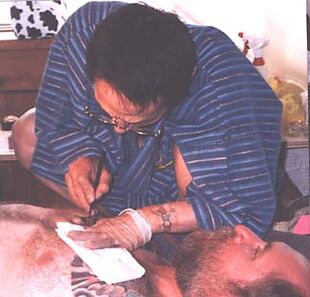Ane-san
There is more to traditional Japanese tattoo besides beautiful body art, and that includes the complex relationship between the Horimono master and his apprentice. While modern tattoo techniques have undermined the old tebori culture, it is still an important part of tattoo history.
Uchideshi
Traditional craftsmen (including tattoo artists) historically learned their trade by undergoing deshiiri, a process in which one formally becomes an apprentice to an older master. An Uchi-deshi is an apprentice who lives with his master, a horishi and carries out menial chores and housework in addition to his studies. The uchideshi receives no payment, and pays no money to his master until after he has completed his apprenticeship; however, he receives board, clothing and food during his time as a student. After a five year term of training, the pupil works independently for one year and gives the income from this year to his or her master(s) to express gratitude. This year of service is called oreiboko.
The Uchi-deshi system first arose among the skilled craftsmen of Edo during the mid-18th century, along with the lineage nomenclature that still exists today. Upon retirement, a master would bestow upon his apprentice his professional name, but with the suffix 'The Second' added to it. This carries on ad infinitum i.e. "The Third, The Fourth etc" with successive generations. This hereditary naming system applies to almost all artisan professions in Japan, including tattoo artists.
In modern times, the Uchi-deshi is a rapidly diminishing phenomenon as more students undergo part-time apprenticeships. These apprentices are therefore able to support themselves with other part-time jobs and maintain homes of their own, commuting to their masters' workplaces instead.
Hori
Coming from the Japanese verb horu meaning to "dig" or "engrave", Hori or Horishi is an honorific meaning "trained artist", shi meaning "master" or "teacher", given by the Horimono master to his Uchi-deshi upon the completion of their formal apprenticeship. 'Hori' and then the rest of the name was usually indicative of the region in which the artist worked. Often, the Hori name is passed from one generation of artist to another. ie: Horiyoshi III.
Some people use the word Irezumi-shi. In the Edo Period, the word Horimonoshi was the most common way to refer to a tattoo artist, to distinguish him from the Horishi who carved woodblocks for Ukiyo-e prints. It is generally considered normal to add the honorific suffix, san ("Mr. Tattoo Artist") to Horishi when used in conversation.
In modern day Japan, new school tattooists do not take on Hori names, and now, Hori names are used mostly for artists still practicing tebori, the traditional Japanese hand tattooing. Whilst speaking in person to a traditional Japanese tattoo artist, one usually uses the generic term sensei (lit. 'one's elder') in the third person, as a mark of respect.
Ane-San
Ane-san or Okami-san is a term or title of respect given by the apprentice to the wife of the Horishi.
